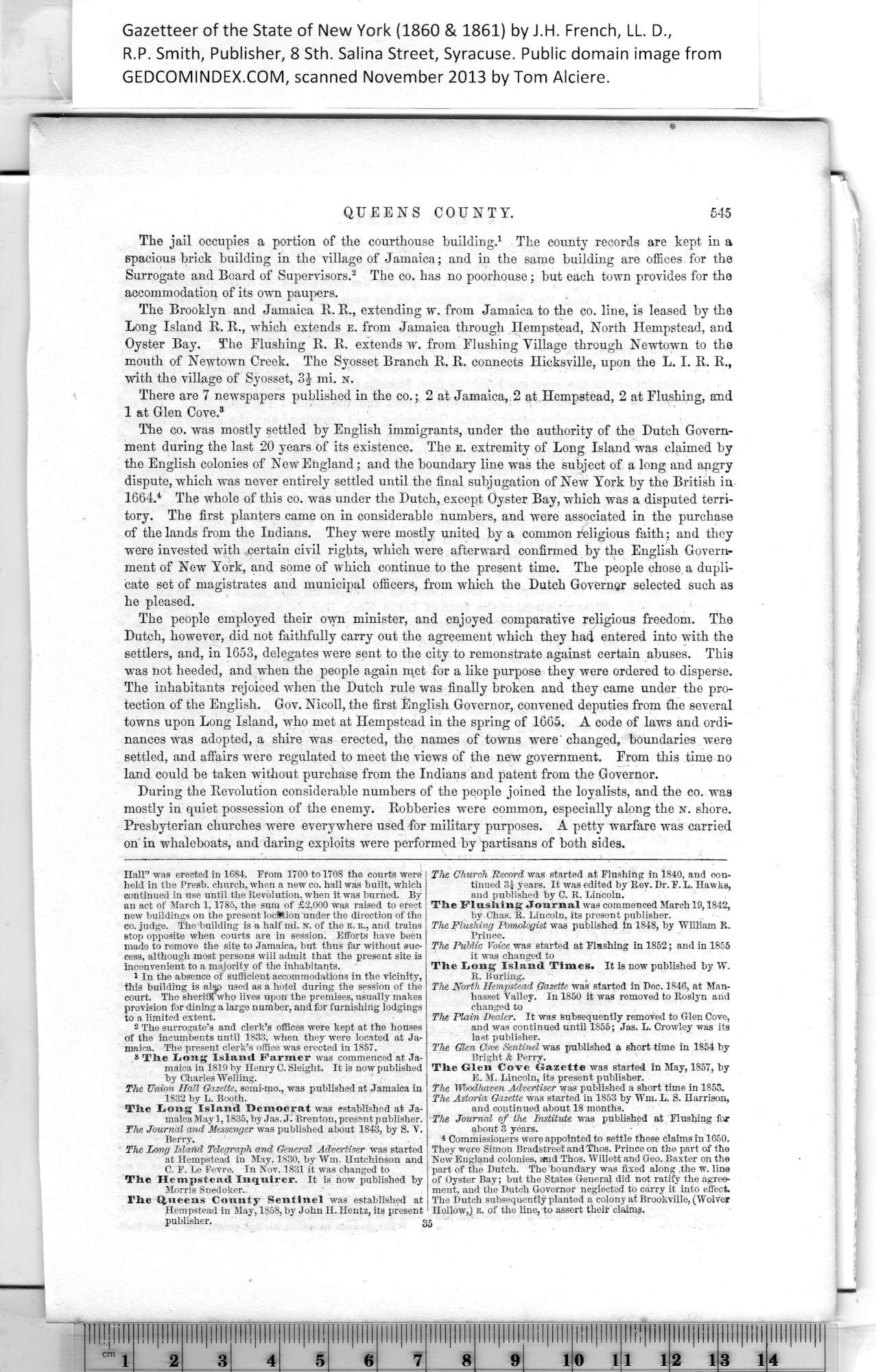|
QUEENS COUNTY. 545
The jail occupies a portion of the courthouse building.1 The county records are kept in a
spacious brick building in the village of Jamaica; and in the same building are offices for the
Surrogate and Board of Supervisors.2 The co. has no poorhouse; but each town provides for the
accommodation of its own paupers.
The Brooklyn and Jamaica R. R., extending w. from Jamaica to the co. line, is leased by the
Long Island R. R., which extends e. from Jamaica through Hempstead, North Hempstead, and
Oyster Bay. The Flushing R. R. extends w. from Flushing Village through Newtown to the
mouth of Newtown Creek. The Syosset Branch R. R. connects Hicksville, upon the L. I. R. R.,
with the village of Syosset, 3| mi. n.
There are 7 newspapers published in the co.; 2 at Jamaica, 2 at Hempstead, 2 at Flushing, and
1 at Glen Cove.2
The co. was mostly settled by English immigrants, under the authority of the Dutch Govern¬
ment during the last 20 years of its existence. The e. extremity of Long Island was claimed by
the English colonies of New England; and the boundary line was the subject of a long and angry
dispute, which was never entirely settled until the final subjugation of New York by the British in
1664.3 The whole of this co. was under the Dutch, except Oyster Bay, which was a disputed terri¬
tory. The first planters came on in considerable numbers, and were associated in the purchase
of the lands from the Indians. They were mostly united by a common religious faith; and they
were invested with certain civil rights, which were afterward confirmed by the English Govern¬
ment of New York, and some of which continue to the present time. The people chose a dupli¬
cate set of magistrates and municipal officers, from which the Dutch Governor selected such as
he pleased.
The people employed their own minister, and enjoyed comparative religious freedom. The
Dutch, however, did not faithfully carry out the agreement which they had entered into with the
settlers, and, in 1653, delegates were sent to the city to remonstrate against certain abuses. This
was not heeded, and when the people again met for a like purpose they were ordered to disperse.
The inhabitants rejoiced when the Dutch rule was finally broken and they came under the pro¬
tection of the English. Gov. Nicoll, the first English Governor, convened deputies from the several
towns upon Long Island, who met at Hempstead in the spring of 1665. A code of laws and ordi¬
nances was adopted, a shire was erected, the names of towns were'changed, boundaries were
settled, and affairs were regulated to meet the views of the new government. From this time no
land could be taken without purchase from the Indians and patent from the Governor.
During the Revolution considerable numbers of the people joined the loyalists, and the eo. was
mostly in quiet possession of the enemy. Robberies were common, especially along the n. shore.
Presbyterian churches were everywhere used for military purposes. A petty warfare was carried
on in whaleboats, and daring exploits were performed by partisans of both sides.
The Church Record was started at Flushing in 1840, and con¬
tinued 3| years. It was edited by Rev. Dr. F. L. Hawks,
and published by C. R. Lincoln.
Tlie Flushing Jonrnal was commenced March 19,1842,
by Chas. R. Lincoln, its present publisher.
The Flushing Pomologist was published in 1848, by William R.
Prince.
The Public Voice was started at Flushing in 1852; and in 1855
it was changed to
The Iiong Island Times. It is now published by W.
R. Burling.
The North Hempstead Gazette was started in Dec. 1846, at Man-
hasset Valley. In 1850 it was removed to Roslyn and
changed to
The Plain Dealer. It was subsequently removed to Glen Cove,
and was continued until 1855; Jas. L. Crowley was its
last publisher.
The Glen Cove Sentinel was published a short time in 1854 hy
Bright & Perry.
The Grlen Cove Gazette was started in May, 1857, by
E. M. Lincoln, its present publisher.
The Woodhaven Advertiser was published a short time in 1853.
The Astoria Gazette was started in 1853 by Wm. L. S. Harrison,
and continued about 18 months.
The Journal of the Institute was published at Flushing for
about 3 years.
4 Commissioners were appointed to settle these claims in 1650.
They were Simon Bradstreet and Thos. Prince on the part of the
New England colonies, amd Thos. Willett and Geo. Baxter on the
part of the Dutch. The boundary was fixed along the w. line
of Oyster Bay; but the States General did not ratify the agree¬
ment, and the Dutch Governor neglected to carry it into effect.
The Dutch subsequently planted a colony at Brookville, (Wolver
Hollow,) e. of the line, to assert their claims.
1
In the absence of sufficient accommodations in the vicinity,
this building is alsp used as a hotel during the session of the
court. The eherif^Vho lives upon the premises, usually makes
provision for dining a large number, and for furnishing lodgings
to a limited extent.
2
® THe Jjong Island Farmer was commenced at Ja¬
maica in 1819 by Henry C. Sleight. It is now published
hy Charles Welling.
The Union Hall Gazette, semi-mo., was published at Jamaica in
1832 hy L. Booth.
Tlie Long Island Democrat was established at Ja¬
maica May 1, 1835, hy Jas. J. Brenton, pressnt publisher.
The Journal and Messenger was published about 1843, by S. V.
Berry.
The Long Island Telegraph and, General Advertiser was started
at Hempstead in May, 1830, by Wm. Hutchinson aud
C. F. Le Fevre. In Nov. 1831 it was changed to
The Hempstead Inquirer. It is now published by
Morris Snedeker..
3
Tlie queens County Sentinel was established at
Hempstead in May, 1858, by John H. Heutz, its present
publisher. 35
| 